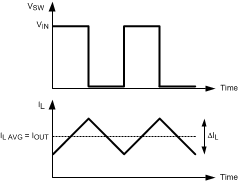SNVS671F February 2011 – May 2019 LM21212-1
PRODUCTION DATA.
- 1 Features
- 2 Applications
- 3 Description
- 4 Revision History
- 5 Description
- 6 Pin Configuration and Functions
- 7 Specifications
- 8 Detailed Description
- 9 Application and Implementation
- 10Layout
- 11Device and Documentation Support
- 12Mechanical, Packaging, And Orderable Information
Package Options
Mechanical Data (Package|Pins)
- PWP|20
Thermal pad, mechanical data (Package|Pins)
- PWP|20
Orderable Information
9.2.1.5 Inductor Selection
The inductor (L) used in the application will influence the ripple current and the efficiency of the system. The first selection criteria is to define a ripple current, ΔIL. In a buck converter, it is typically selected to run between 20% to 30% of the maximum output current. Figure 30 shows the ripple current in a standard buck converter operating in continuous conduction mode. Larger ripple current will result in a smaller inductance value, which will lead to a lower series resistance in the inductor, and improved efficiency. However, larger ripple current will also cause the device to operate in discontinuous conduction mode at a higher average output current.
 Figure 30. Switch And Inductor Current Waveforms
Figure 30. Switch And Inductor Current Waveforms Once the ripple current has been determined, the appropriate inductor size can be calculated using the following equation:
